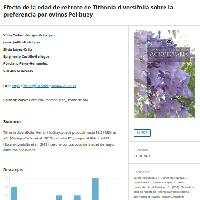Resumen
-
Introducción. Tithonia diversifolia (Hemsl.) A. Gray, puede producir hasta 19.5 t MS/ha/ año (Castro et al., 2017), con alta PC y degradabilidad de MS (Botero-Londoño et al., 2019), pero se conoce poco de la edad de mayor consumo por ovinos. Objetivo. Evaluar la preferencia de ovinos por follaje T. diversifolia en distintas edades de rebrote. Métodos. Se realizó en CEIEGT-FMVZ-UNAM con clima Af(m)w”(e), 23.5 °C de temperatura media anual y 1 991 mm anuales de precipitación pluvial. Se utilizó planta completa de 42, 56 y 70 d de rebrote. Se utilizaron ocho ovinos adultos Pelibuey (52 kg PV y 14 meses de edad); con experiencia en el consumo de T.diversifolia, y pastaron Cynodon nlemfuensis 23.5 horas del día y en corral diariamente durante 15 min más 15 min de traslado de 12:00 a 12:30 h se ofrecieron 600 g de forraje verde picado de planta completa, complemento, equivalentes a 77.1, 84.6 y 91.7 g MS de 42, 56 y 70 d, respectivamente. Se evaluó la preferencia mediante el consumo de follaje fresco ofrecido en periodos de 15 min durante 10 días. El análisis estadístico utilizó PROC GLM con SAS 9.3. Resultados y discusión. El consumo de MS de T. diversifolia a 42, 56 y 70 d de rebrote en periodos de 15 min fue 62.6±2.1; 42.7±3.1; 34.7±3.7 g MS, respectivamente (P<0.0001). Los ovinos prefirieron (P<0.05) el follaje de 42 d de rebrote, seguido por 56 y 70 d. García et al. (2008), indicaron que a mayor edad menor consumo, esto puede ser por la calidad nutricia a los 42 d. Conclusiones. Los ovinos consumen el follaje de esta especie a cualquier edad ofrecida entre 42 y 70 d de edad, sin embargo, prefieren el follaje de menor edad.
-
Introduction. Tithonia diversifolia (Hemsl.) A. Gray, can produce up to 19.5 tons of DM ha-1 year-1 (Castro et al., 2017), with high CP and DM degradability (Botero-Londoño et al., 2019), but little is known about the age of highest consumption by sheep. Objective. Evaluate preference of sheep for T. diversifolia foliage at different regrowth ages. Methods. It was carried out in CEIEGT-FMVZ-UNAM with climate Af (m)w”(e), 23.5 °C of annual mean temperature and 1 991 annual mm of rainfall. A complete plant of 42, 56 and 70 d of regrowth was used. 8 adult Pelibuey sheep were used (52 kg LW and 14 months of age); with experience in the consumption of T. diversifolia, and Cynodon nlemfuensis grazed 23 hours a day and in a corral daily for 15 min plus 15 min transfer of 12:00 to 12:30 h, 600 g of chopped green whole plant forage were offered equivalent to 77.1, 84.6 and 91.7 g MS of 42, 56 and 70 d, respectively. Preference was evaluated by consuming fresh foliage offered in periods of 15 min for 10 days. Statistical analysis used PROC GLM with SAS 9.3. Results and discussion. The DM intake of T. diversifolia at 42, 56 and 70 d of regrowth in periods of 15 min was 62.6±2.1; 42.7±3.1; 34.7±3.7 g MS, respectively (P<0.0001). Sheep preferred (P<0.05) the foliage of 42 d of regrowth, followed by 56 and 70 d. He indicated that the older the less consumption, this may be due to the nutritional quality at 42 d (García et al., 2008). Conclusions. Sheep consume the foliage of this species at any age offered between 42 and 70 d of age, however, they prefer the youngest foliage that has a higher nutritional quality.
